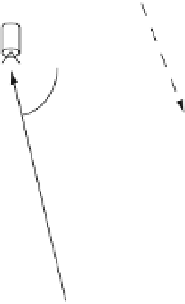Geography Reference
In-Depth Information
by bank material. TIR remote sensing of water involves
a trade-off between having a pixel size fine enough to
identify spatial patterns and reduce mixing with bank
materials, and coarse enough so that the cost of fly-
ing large areas is not prohibitive. TIR satellite-based
images generally cover large areas (e.g. ASTER images
cover a ground area of 3600 km
2
and Landsat ETM
+
∼
34200 km
2
), but their pixel sizes are commonly too
coarse to resolve the river channel, except for the widest
rivers. However their low cost, capability for regional
coverage, and the potential for repeat monitoring with
systematic image characteristics, make satellite-based TIR
imaging sensors attractive if the pixel size is suitable for
the river size. Airborne- and ground-based platforms
produce TIR images with finer pixel sizes suitable for
narrower rivers. Ground based TIR imagery can also be
limited by the difficulty in locating sites suitable for the
operation of the TIR sensor at an elevation above the
water to resolve significant amounts of the stream chan-
nel. Further discussion of the characteristics of different
sensor platforms can be found in Section 5.5.
For pixels that are not pure, such as for edge pixels
that are a mixture of the bank and water, either a single
emissivity needs to be assumed for the pixel, resulting
in additional error for the temperature estimation for
the pixel, or some method needs to be used to unmix
the pixel. For example, the pixel can be unmixed using
a spectral mixture analysis (Gillespie, 1992; Gustafson
et al., 2003; Sentlinger et al., 2008, Gu et al., 2008).
Clear sky
Thermal
sensor
θ
Atmosphere
Surface roughness
Emitted
Reflected
Figure 5.8
Sources of emitted and reflected TIR radiation in
thermal remote sensing of rivers and streams (Torgersen et al.,
2001, Figure 1). Reprinted from
Remote Sensing of Environment
,
76
(3), Torgersen, C.E. et al., Airborne thermal remote sensing
for water temperature assessment in rivers and streams,
pp. 386-398, Copyright 2001, with permission from Elsevier.
radiation (Figure 5.8). TIR radiation emitted from near-
bank objects may pass directly into the path of the sensor,
resulting in erroneous image interpretation, particularly
when the bank material's temperature is very different
from the water temperature. This is particularly problem-
atic for ground-based TIR imaging sensors observing the
water from the bank with a large observation angle (e.g.
Handcock et al., Figure 7b, 2004; Cardenas, et al., Figure
2, 2008). TIR radiation emitted from near-bank objects
may also be scattered or reflected from other surfaces into
the sensor, both of which will increase the measured T
r
.
This multiple scattering effect is small compared to the
temperature of the water. For example, for a tree with
a temperature of 25
◦
C and water at 17
5.4.3 Thenear-bankenvironment
The near-bank environment includes objects with a wide
variety of temperatures and emissivities. It includes bark,
branches, grasses, leaves, soil, sand, and rocks. Depend-
ing on the season, the time of day, and whether the
near-bank objects are shaded, they may be warmer or
cooler than the water. For example, for summer day-time
observations, sun-lit rocks and woody debris exposed
during low water levels could be warmer than the water.
In comparison, a gravel-bar shaded by the trees could be
cooler than adjacent water and would be confused with
cold water inputs, as could riparian vegetation cooled by
evapo-transpiration. These examples illustrate the sort of
complexities found in image interpretation of TIR images
in a riverine landscape.
Emitted radiation from the near-bank environment
of vegetation and rocks can reach the sensor directly
or be scattered from the river surface as the result of
emission, reflection, and multiple-scattering of emitted
2
◦
C there is a
calculated increase in the observed water temperature of
0
.
65
◦
C, respectively, depending on the viewing
geometry (Handcock et al., 2006). When the bank vege-
tation is tall compared to the width of the river it may
not be possible to find regions in the river centre that
are not contaminated by scattered radiation emitted by
the bank vegetation. In situations where it is difficult to
obtain pure-water pixels, higher resolution imagery may
be needed, and more than 10 pixels may need to be sam-
pled from the imagery to resolve T
r
accurately (Torgersen
et al., 2001).
10
◦
C-0
.
.


















Search WWH ::

Custom Search